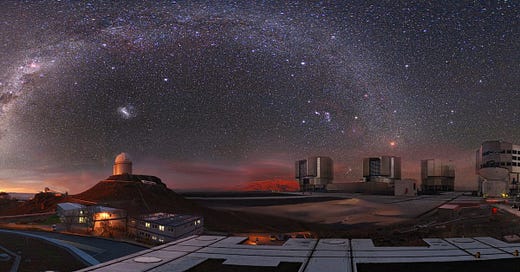Stanford Prof says US is ‘Reverse-Engineering Downed UFOs' to JWST's Hunt for Dead Solar Systems
Weekend Edition
This weekend’s stories include: James Webb Telescope finds evidence of 'celestial monster' stars the size of 10,000 suns lurking at the dawn of time and The Universe wasn’t born “ready for life”.
James Webb Telescope finds evidence of 'celestial monster' stars the size of 10,000 suns lurking at the dawn of time, reports Ben Turner for Live Science. The JWST has found key chemical fingerprints of supermassive stars just 440 million years after the Big Bang.
JWST Will Hunt for Dead Solar Systems—And Much More—In Its Second Year of Science, reports Jonathan O'Callaghan for Scientific American--White dwarfs, Earth-sized exoplanets, early galaxies and even Saturn’s moon Enceladus are on the agenda for JWST’s second year in space, but exomoons and others miss out
Nobel-Winning Exoplanet Hunter Says Astrobiology Will Remain A Long, Hard Slog, reports Bruce Dorminey for Forbes. "The Nobel Prize-winning Swiss astronomer Michel Mayor —- who along with Didier Queloz indirectly detected the first planet circling another sun-like star —- says exoplanet hunters and astrobiologists have a long, hard slog ahead of them if they ever hope to find proof of extraterrestrial life."
JWST’s Newfound Galaxies Are the Oldest Ever Seen--We now know that the first galaxies in our universe formed shockingly fast, thanks to the latest results from the James Webb Space Telescope, reports Jonathan O'Callaghan for Scientific American. "Are the galaxies the James Webb Space Telescope (JWST) is seeing in the early universe really as astonishingly remote as we think they are? So far, the answer is a resounding yes. “The vast majority of these galaxies are being confirmed,” says Steven Finkelstein, an astronomer at the University of Texas at Austin.
What happened to the missing stars at the heart of our Milky Way galaxy? probes Keith Cooper for Space.com. "The Milky Way's central supermassive black hole may be to blame."
Nope, the Universe wasn’t born “ready for life”, reports Big Think. "It took many stages of cosmic evolution, from baryogenesis to hadronization to Big Bang nucleosynthesis to the formation of neutral atoms, before stars could finally create the ingredients for life. Even though the raw ingredients weren't there for life at the start of the Big Bang, their predecessors were."
We’re effectively alone in the Universe, and that’s OK--Solitude is not a curse—it urges us to explore the mysteries of our galaxy and beyond, observes Paul Sutter for Ars Technica. Is Life common, but intelligence is not?
Astronomers Disturbed by the Unexpected Scale of James Webb’s Galaxies, reports SciTechDaily. "A new study from the Cosmic Dawn Center suggests an effect that has never before been studied at such early epochs, indicating that the galaxies may be even more massive."
Stanford professor says aliens are ‘100 per cent’ on earth, US is ‘reverse-engineering downed UFOs’. Stanford professor, Dr Garry Nolan, who has researched unidentified aerial phenomena for the US government has made a stunning claim about the aliens, reports Frank Chung for News.com au. Nolan also claimed that whistleblowers who have worked on “reverse-engineering downed craft” had recently given classified testimony to Congress, creating a “hornet’s nest in Washington”.
Scientists watched a 'reappearing supernova' explode 5 times in a row — and it could help reveal how fast the universe is expanding, reports Live Science. "In new research, scientists triangulated measurements of the supernova's location to calculate a new value for the Hubble constant. According to the new study, the universe is expanding at a rate of about 41.4 miles per second (66.6 kilometers per second) per megaparsec (or for every 3.2 million light-years).
Curated by The Galaxy Report Editorial Staff




